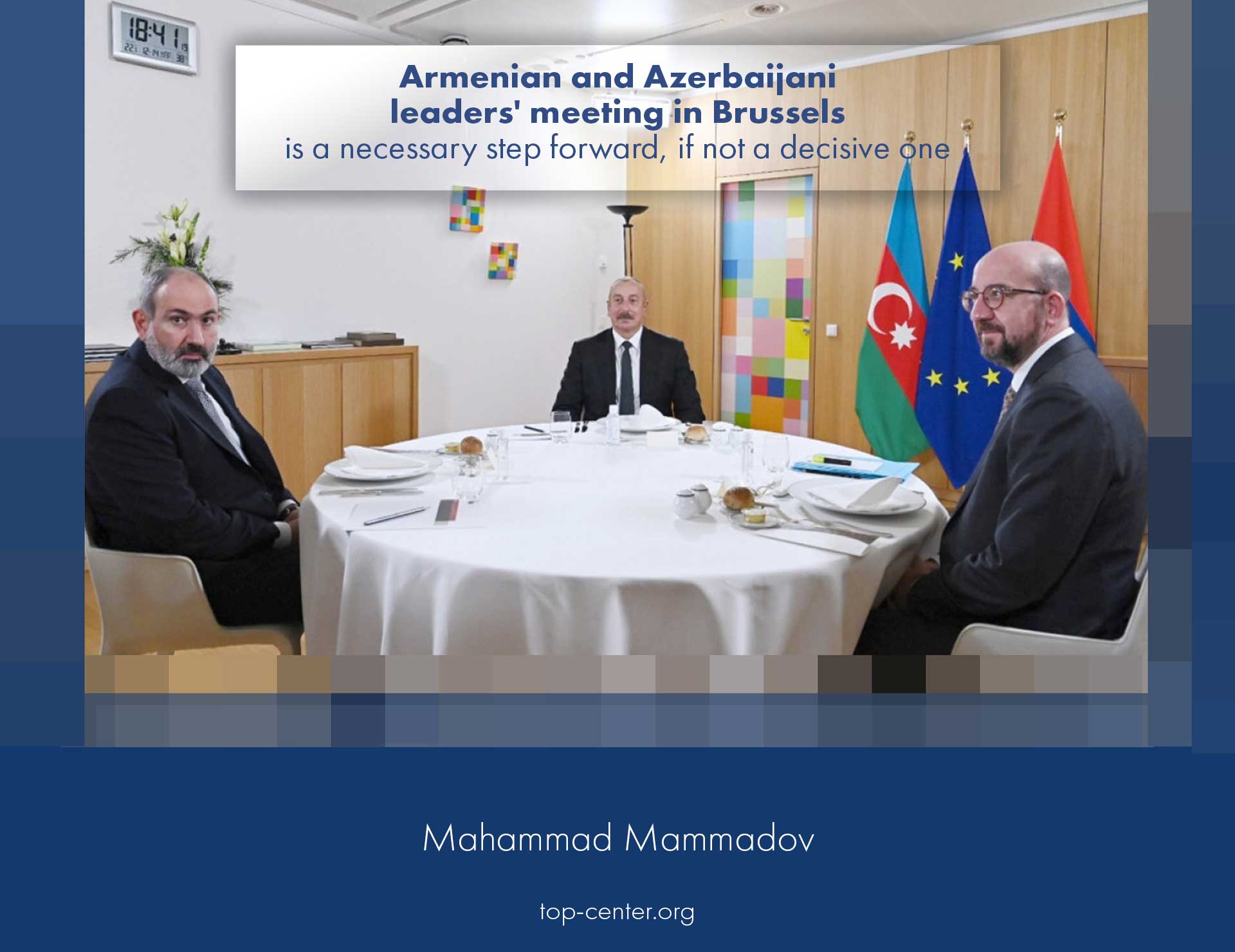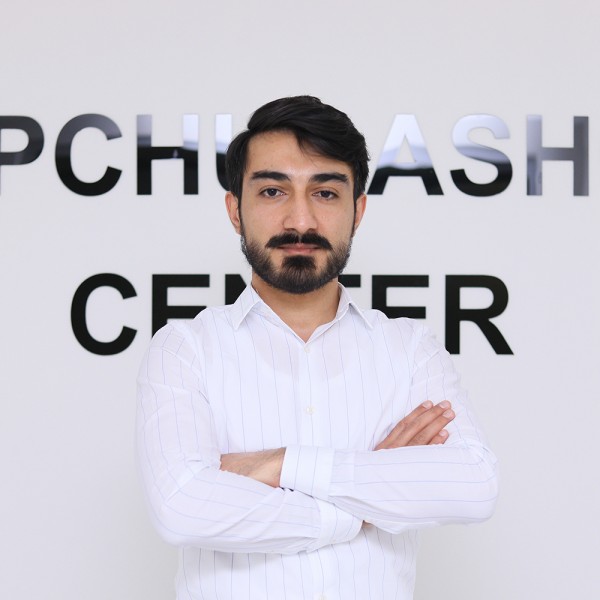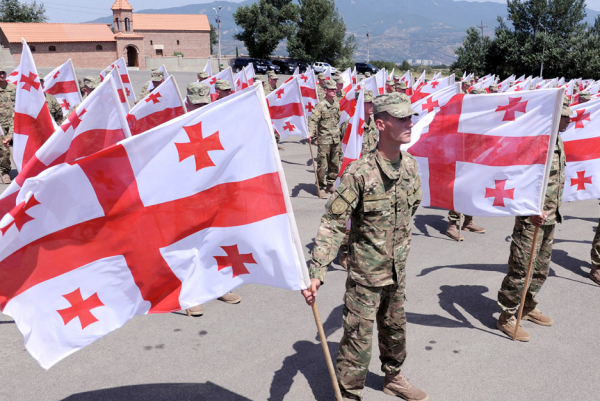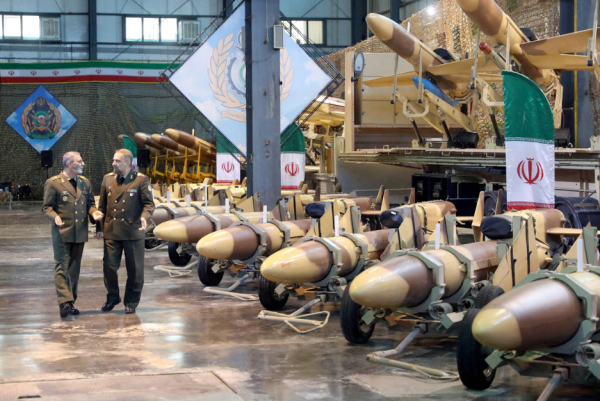Armenian and Azerbaijani leaders' meeting in Brussels is a necessary step forward, if not a decisive one

Against the background of simmering tensions between Armenia and Azerbaijan in recent months, a trilateral meeting between the president of the European Council Charles Michel, Armenia’s prime minister Nikol Pashinyan, and Azerbaijan’s President Ilham Aliyev in the margins of the sixth Eastern Partnership summit on December 15 was a good omen. It was the first time the EU president was hosting the leaders of the two countries to discuss key issues pertaining to peace and stability in the South Caucasus. At the same time, the two leaders held a one-on-one meeting, the first of its kind since the end of last year’s war in Karabakh, that might pave the way for the next phase of successful diplomatic contacts in the future.
According to the statement of the EU president after the meeting, Armenia and Azerbaijan reconfirmed their readiness to ensure the fulfillment of commitments resulting from the two trilateral declarations of 9 November 2020 and 11 January 2021, together with the recent understandings reached in Sochi on 26 November with the mediation of Russian president Vladimir Putin. Most important of all, the two sides agreed to take further tangible steps on border delimitation and demarcation issues and restoring communications infrastructure between the countries while fully respecting each other’s sovereignty. On his side, the EU leader assured his interlocutors of Brussels’ support to the creation of an atmosphere of trust, “with a view to sustainable peace in the region, ultimately underpinned by a comprehensive peace agreement.”
In the midst of arguments on whether the results of the Brussels meeting was “significant” as claimed by president Michel or amounted to nothing more than a PR exercise, Nikol Pashinyan declared the agreement on the construction of the Yeraskh-Julfa-Ordubad-Meghri-Horadiz railway that will connect Azerbaijan’s liberated western regions with its Nakhchivan exclave and give Armenia access to Iran and Russia through Azerbaijani territory. On December 18, Armenia’s deputy prime minister Mher Grigoryan said the government plans to restore the 45-kilometer section of the railway passing through Armenia’s territory with a cost of about $200 million. On the Azerbaijani side, president Aliyev noted that Baku has already started the construction process and the railroad section from Horadiz to the Armenian border will be completed by the end of 2023.
As another sign of goodwill, Azerbaijan released 10 Armenian detainees captured during the November 16 skirmishes along the state borders. President Michel welcomed the move as a “humanitarian gesture demonstrating the mutual will to strengthen confidence as discussed in Brussels”. Yet, Azerbaijan expects Armenia to fulfill its part of the promises as the EU statement after the trilateral talks links Azerbaijan’s release of further detainees to Armenia’s addressing the fate of missing persons as a result of the First Karabakh War in the early 1990s. According to Azerbaijan’s State Commission on Prisoners of War, Hostages, and Missing Persons, the fate of 3890 people remains unknown to this day. So far Azerbaijan has returned the remains of more than 1600 Armenian military personnel from the Second Karabakh War and similar steps taken by the Armenian side would highly contribute to creating an environment conducive to progress towards peace and reconciliation.
Besides certain success on economic and humanitarian matters, the Brussels meeting also shed light on the current negotiation position of Armenia and Azerbaijan and the EU’s place in the mostly Russia-led peace-making process. On the one hand, the EU’s policy narratives are designed to make sure the two countries cooperate within the parameters of the trilateral statements mediated by Russia, hence indirectly accepting Moscow’s leading position in the negotiations. Amid the growing uncertainty around the migrant crisis with Belarus and military build-up around Ukraine, the preservation of peace and stability in the South Caucasus is in the interests of the EU and Russia. At the same time, unlike the other conflict centers in Eastern Europe, on the Armenia-Azerbaijan conflict, there has been a larger room for understanding to promote cooperative security as the two regional behemoths do not operate in a zero-sum environment on this issue. “Joint Communication on the EU’s relations with Russia” presented to the European Council in June, envisages a three-tiered strategy - push-back, constrain, engage - aiming to put relations with Russia on a firmer track and any EU-Russia understanding on the stability in the South Caucasus could be an essential component of the “engagement” diplomacy.
Baku and Yerevan also benefit from EU support to Russia-led peace-making efforts. For the Pashinyan government, Brussels’ economic and diplomatic support to the realization of projects mentioned in trilateral statements with Russia will strengthen his hand against both pro-West and pro-Russia groups in domestic politics. Reconciliation with Azerbaijan and Turkey has long been a thorny issue in Armenia and the EU’s involvement in the process will in some way inspire the government to take bolder steps towards regional cooperation. For Azerbaijan, the EU’s constructive engagement with the negotiations process affords Baku many opportunities to cement the existing status quo and cultivate a predictable security environment conducive to European and Russian interests. In this context, president Michel’s emphasis on the need for the signing of a comprehensive peace agreement and the absence of statements on Karabakh’s status is totally in line with Azerbaijan’s post-war foreign policy narratives.
On the other hand, the EU leadership saw the Brussels meeting as an opportunity to push its own agenda on Armenia-Azerbaijan negotiations, with an overarching goal of recovering its damaged image after the Second Karabakh War. What makes this attempt different from the previous ones is the EU’s direct involvement in confidence-building measures rather than merely supporting the currently-defunct OSCE Minsk Group’s activities. It should come as no surprise that president Michel’s statement after the trilateral meeting omitted the Minsk Group.
Against this background, the successful establishment of a direct communication line between the ministers of defense of Armenia and Azerbaijan, facilitated by the EU president on November 19, was a significant development that will help de-escalate tensions on the ground. As in the case of the organization of a face-to-face meeting of state leaders, here too, the initiative serves the idea that normalization in current conditions could best be achieved by direct contacts between the two sides. It would also gradually decrease Russia’s ability to use tensions for its own benefits. On border delimitation and demarcation issues, Brussels offers an expert mission or consultative group to facilitate the process by providing assistance to both countries. As the November 16 clashes indicated, the center of gravity of escalations has shifted from the Karabakh region to state borders and the EU understands that practical achievements on border delimitation would decrease strategic uncertainty, helping pave the way for constructive cooperation. Last but not least, Brussels intends to launch an economic advisory platform to contribute to peaceful coexistence in the region. What this all means in practical terms, however, remains unclear. In a most likely scenario, Brussels might use the platform to better support the development of rail and road links between Armenia and Azerbaijan, in line with the Economic and Investment Plan declared in the Eastern Partnership summit on December 15. Although the investment projects in the plan do not cover the connectivity links between the two countries, the EU could still leverage the voting power of its member states in multilateral development banks to help finance certain segments of the transport arteries.
For Armenia, the EU’s direct participation in the reconciliation process and its increasing role in the rejuvenation of regional economies open up certain avenues to decrease its vile dependence on Russia that became more visible after the humiliating defeat in the Second Karabakh War. In this context, the Brussels meeting provided an alternative platform to the mostly Russia-led negotiation process, giving Yerevan and Baku certain maneuvering space to signal their unmet expectations with regard to the ongoing trilateral talks. It was most notably seen in president Aliyev’s meeting with the NATO secretary-general Jens Stoltenberg where he claimed the Zangezur Corridor connecting Azerbaijan’s western regions with its Nakhchivan exclave should have exactly the same customs regime as Lachin Corridor linking Armenia to Karabakh. Accordingly, either the two sides will agree on the establishment of customs checkpoints on both routes, or they will both provide unimpeded movement of cargo/people as mentioned in the November 10 declaration. Although ambiguous, the EU president’s statement also highlighted “appropriate arrangements for border and customs control, based on the principle of reciprocity”. Passage through the Lachin Corridor is currently under the control of the Russian peacekeepers and the Azerbaijani president’s call for the changes to its legal regime in NATO and the EU headquarters was probably a message to the Russian side to push Armenia further on the fulfillment of the major tenets of the trilateral statements.
Taken together, the Brussels meeting could be considered a relative success for the future of the Armenia-Azerbaijan negotiations and the EU’s place in it. But whether the sides will be able to build on current achievements to make further improvements in the future will depend mostly on Brussels’ capacity and willingness to project power amid the growing internal and external challenges; domestic developments in Armenia and Azerbaijan; and Russia’s approach to the regional conflicts in the context of the deepening tensions with the West.







